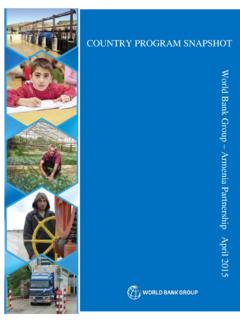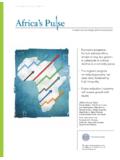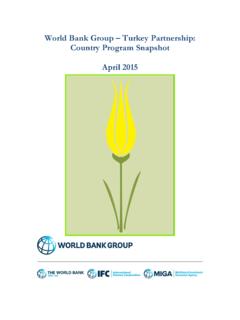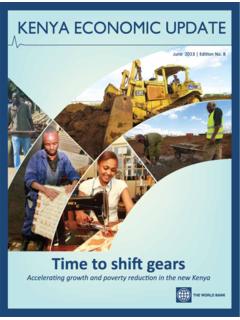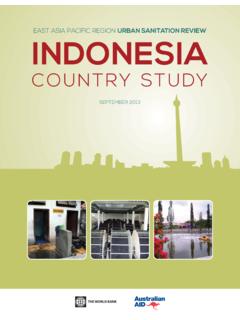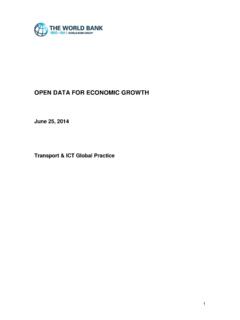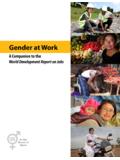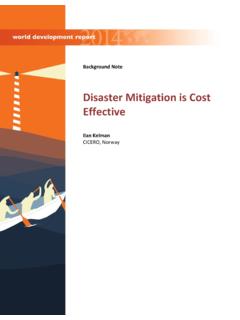Transcription of Stop Conflict, Reduce Fragility and End ... - World Bank
1 Stop Conflict, Reduce Fragility and End Poverty: Doing Things Differently in Fragile and Conflict-affected Situations 1. One of the great development challenges of our time is to help countries affected by conflict and Fragility find a path towards sustainable peace and development. The World bank Group has set the twin goals of ending extreme poverty within a generation and boosting shared prosperity in all countries. Reaching those goals means sharpening the focus on the World s fragile and conflict affected situations. They are the most challenged in the developing World in meeting the Millennium Development Goals (MDGs) by 2015 - a deadline now less than 1000 days away. 2. As the 2011 World Development Report on Conflict, Security and Development revealed, one in four people on the planet live in areas affected by repeated cycles of political and criminal violence.
2 People in fragile and conflicted-affected situations (FCS)1 are more than twice as likely to be under-nourished as those in other developing countries, more than three times as likely to be unable to send their children to school, twice as likely to see their children die before age five, and more than twice as likely to lack clean water. Half of all child deaths occur in conflict affected areas. 3. On average, a country that experiences major violence has a poverty rate significantly higher than a country that had no violence. A similar picture emerges for areas affected by violence in richer and more stable countries areas where development lags behind. While many developing countries have made tremendous progress in poverty reduction over the last decade, many fragile and conflict-affected situations have experienced repeated cycles of violence that undermines development progress.
3 4. To meet the challenge of ending extreme poverty by 2030, there is a clear case for an even greater focus on the fragile and conflict affected states and situations. Recent World bank research shows that some countries can get caught in a Fragility trap, a low-level equilibrium with the self-reinforcing features of weak institutions, low investment, slow growth and the possibility of repeated cycles of A civil conflict costs the average developing country roughly 30 years of GDP 5. Despite these devastating impacts, countries can and do find pathways out of Fragility and conflict. Since 2004, 11 countries have graduated from fragile state status through steady progress in building institutions and strengthening These countries had economic 1 Unless otherwise specified, the term FCS in this document refers to countries or territories that have a harmonized average Country Policy and Institutional Assessment (CPIA) rating of or less (or no CPIA), and/or have or have had a UN and/or regional peace-keeping or peace-building mission during the past three years.
4 In 2013, FCS included 31 IDA eligible countries, 3 IBRD eligible countries and the territory of West bank and Gaza. 2 Noro Aina Andrimihaja, Matthias Cinyabuguma and Shanta Devarajan (Nov 2011), Avoiding the Fragility Trap in Africa, World bank Africa Region Policy Research Working Paper 5884). 3 World Development Report 2011 on Conflict, Security and Development, hereafter WDR 2011. 4 Cambodia, Djibouti, the Gambia, Georgia, Lao PDR, Niger, Nigeria, Papua New Guinea, Sao Tome and Principe, Tajikistan and Uzbekistan. growth rates of percent on average. Experiences from Chile, Colombia, Ghana, Indonesia, Mozambique, and South Africa show that sustained efforts to build institutions that address the stresses and strains driving conflict can achieve results. There is still much to learn from these good examples, but the most important lesson is that countries can find their own way out of Fragility .
5 Their paths are generally long and complex with many risks and reversals. In most, the international community has played an important role in supporting governments, the private sector and civil society in the long term transformation process out of Fragility and conflict. Some Signs of Progress 6. With less than 1000 days to go before the 2015 deadline, fragile states seriously lag behind the rest of the developing World in terms of meeting the Millennium Development Goals (MDGs). The majority of MDG targets in fragile states will not be met (see figure 1). Figure 1: Progress toward MDG targets by group within developing countries, based on data from the Global Monitoring Report 2013. 2 4 6 0 2 6 1 1 0 2 6 1 0 2 9 4 3 8 -40-30-20-1001020 Access to ImprovedSanitationAccess to Improved WaterMaternal MortalityInfant MortalityUnder 5 MortalityRatio Girls to Boys inEducationPrimary CompletionUndernourishmentPovertyFragile and Conflict-Affected States 3 9 12 12 24 5 11 2 12 25 49 7 5 22 52 37 31 58 -100-50050 Non-FCS 7.
6 However the latest World bank analysis5 points to some signs of progress. Twenty FCS have now met one or more MDG targets and an additional six are on track to do so by the deadline of 2015. Eight countries about 20 percent of all fragile and conflict affected states as defined by the World Bank6 have now met the target to halve extreme poverty ahead of 2015, including Guinea, Bosnia and Herzegovina, Nepal, Timor-Leste, and the territory of West bank and Gaza. 8. This reflects a change since the publication of the 2011 World Development Report on Conflict, Security and Development which stated no low income fragile or conflict affected country had yet achieved a single MDG. 9. The analysis points to signs of progress in meeting other targets under the MDGs. Fragile and conflict affected states have made the greatest progress on gender parity in education the ratio of girls to boys enrollment in schools (MDG 3a).
7 Countries including Bosnia and Herzegovina, Kiribati, Federated States of Micronesia, Myanmar, and Tuvalu have met the target and those on track include Burundi, Chad, the Democratic Republic of Congo, Nepal, Timor-Leste, and Yemen. 10. The World has met the target of halving the proportion of people without sustainable access to safe drinking water and basic sanitation, five years ahead of schedule. The analysis shows FCS including Nepal, Tuvalu, Comoros, Myanmar and Afghanistan have already met the target for access to an improved water source. Guinea, Guinea-Bissau and Sierra Leone are on track to achieve the target by 2015. 11. Globally progress on maternal health is lagging, with maternal mortality remaining high in much of the developing World . Fragile states, as a group, started with a similar number of maternal death to Sub-Saharan Africa (780 deaths per 100,000 live birth in 1990) but Nepal has already reached the target of reducing the maternal mortality ratio by three quarters from its 1990 level.
8 Provided current trends continue, Afghanistan, Angola, Eritrea, Timor-Leste and the Republic of Yemen will remain on track to meet the MDG maternal health target. 12. Nepal and Bosnia and Herzegovina stand-out as fragile states with the most success in meeting MDG targets. Nepal has met the poverty target as well as the target on maternal mortality and water. Timor-Leste has met the poverty target and also the target to Reduce by two-thirds, between 1990 and 2015, the under- five mortality rate. The country is also on target on maternal mortality and the ratio of boys to girls in education. Recent figures suggest that Afghanistan has met the improved water target and is on track to meet the target on maternal mortality. 5 Based on analysis of data in the Global Monitoring Report 2013 ,,contentMDK:23391146~pagePK:64165401~pi PK:64165026~theSitePK:476883, 6 Based on the World bank s Harmonised List of Fragile Situations FY13 13.
9 These signs of progress reflect accelerated development in a few countries as well as better quality data for monitoring progress in FCS. But there remain severe challenges to generating the data necessary to track MDGs and feed into policy choices in fragile and conflict-affected states. Nearly a quarter of all MDG targets for FCS have insufficient data to track results. 14. The MDGs have stimulated demand for better statistics and new programs to increase the capacity of developing countries to produce and use statistics. The World bank is working to help countries build up their ability to gather data, in countries such as Afghanistan and the Democratic Republic of Congo. The bank , along with the Africa Development bank , Asian Development bank , Inter-American Development bank , Islamic Development bank , International Monetary Fund, and the United Nations signed a Memorandum of Understanding in April 2013 to strengthen collaboration between the institutions on issues related to data and statistical capacity building in their member countries.
10 15. However, it is clear that FCS as a group still lag seriously behind on most MDGs. On average, FCS are four times more likely to be off track or lack sufficient data to monitor MDG targets than they are to be have met or be on track to meet targets. On some MDG targets, like child mortality, not a single FCS is on track to meet the target by 2015. 16. And the signs of success are themselves fragile. FCS risk relapse into violence or conflict that can reverse progress on development, underscoring the need for sustained action and support. Progress can be reversed as result of renewed conflict and crisis: Yemen was on track to meet the maternal mortality target when violence started during the Arab Spring. Case Studies: A Look Behind the Numbers 17. Despite a ten year armed conflict and post conflict challenges of reaching consensus on the future shape of the state, Nepal has demonstrated significant progress in reducing poverty.
